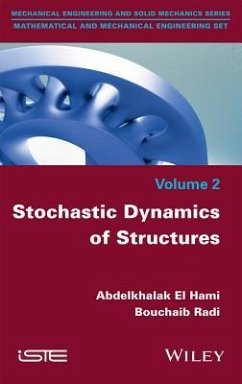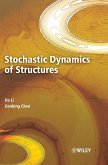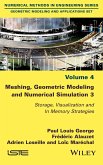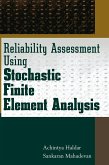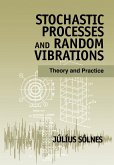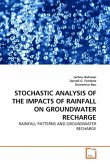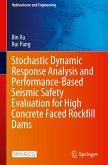- Gebundenes Buch
- Merkliste
- Auf die Merkliste
- Bewerten Bewerten
- Teilen
- Produkt teilen
- Produkterinnerung
- Produkterinnerung
This book is dedicated to the general study of the dynamics of mechanical structures with consideration of uncertainties. The goal is to get the appropriate forms of a part in minimizing a given criterion. In all fields of structural mechanics, the impact of good design of a room is very important to its strength, its life and its use in service. The development of the engineer's art requires considerable effort to constantly improve structural design techniques.
Andere Kunden interessierten sich auch für
![Stochastic Dynamics of Structu Stochastic Dynamics of Structu]() Jie LiStochastic Dynamics of Structu200,99 €
Jie LiStochastic Dynamics of Structu200,99 €![Meshing, Geometric Modeling and Numerical Simulation 3 Meshing, Geometric Modeling and Numerical Simulation 3]() Paul Louis GeorgeMeshing, Geometric Modeling and Numerical Simulation 3164,99 €
Paul Louis GeorgeMeshing, Geometric Modeling and Numerical Simulation 3164,99 €![Reliability Assessment Using Stochastic Finite Element Analysis Reliability Assessment Using Stochastic Finite Element Analysis]() Achintya HaldarReliability Assessment Using Stochastic Finite Element Analysis161,99 €
Achintya HaldarReliability Assessment Using Stochastic Finite Element Analysis161,99 €![Stochastic Processes and Random Vibrations Stochastic Processes and Random Vibrations]() Júlíus SólnesStochastic Processes and Random Vibrations111,99 €
Júlíus SólnesStochastic Processes and Random Vibrations111,99 €![Stochastic Disaggregation of Daily Rainfall for fine timescale Stochastic Disaggregation of Daily Rainfall for fine timescale]() Parvez MahbubStochastic Disaggregation of Daily Rainfall for fine timescale38,99 €
Parvez MahbubStochastic Disaggregation of Daily Rainfall for fine timescale38,99 €![STOCHASTIC ANALYSIS OF THE IMPACTS OF RAINFALL ON GROUNDWATER RECHARGE STOCHASTIC ANALYSIS OF THE IMPACTS OF RAINFALL ON GROUNDWATER RECHARGE]() Jarbou BahrawiSTOCHASTIC ANALYSIS OF THE IMPACTS OF RAINFALL ON GROUNDWATER RECHARGE51,99 €
Jarbou BahrawiSTOCHASTIC ANALYSIS OF THE IMPACTS OF RAINFALL ON GROUNDWATER RECHARGE51,99 €![Stochastic Dynamic Response Analysis and Performance-Based Seismic Safety Evaluation for High Concrete Faced Rockfill Dams Stochastic Dynamic Response Analysis and Performance-Based Seismic Safety Evaluation for High Concrete Faced Rockfill Dams]() Bin XuStochastic Dynamic Response Analysis and Performance-Based Seismic Safety Evaluation for High Concrete Faced Rockfill Dams38,99 €
Bin XuStochastic Dynamic Response Analysis and Performance-Based Seismic Safety Evaluation for High Concrete Faced Rockfill Dams38,99 €-
-
-
This book is dedicated to the general study of the dynamics of mechanical structures with consideration of uncertainties. The goal is to get the appropriate forms of a part in minimizing a given criterion. In all fields of structural mechanics, the impact of good design of a room is very important to its strength, its life and its use in service. The development of the engineer's art requires considerable effort to constantly improve structural design techniques.
Produktdetails
- Produktdetails
- Verlag: Wiley
- Seitenzahl: 350
- Erscheinungstermin: 27. Dezember 2016
- Englisch
- Abmessung: 241mm x 164mm x 27mm
- Gewicht: 662g
- ISBN-13: 9781848219496
- ISBN-10: 1848219490
- Artikelnr.: 45010145
- Herstellerkennzeichnung
- Libri GmbH
- Europaallee 1
- 36244 Bad Hersfeld
- gpsr@libri.de
- Verlag: Wiley
- Seitenzahl: 350
- Erscheinungstermin: 27. Dezember 2016
- Englisch
- Abmessung: 241mm x 164mm x 27mm
- Gewicht: 662g
- ISBN-13: 9781848219496
- ISBN-10: 1848219490
- Artikelnr.: 45010145
- Herstellerkennzeichnung
- Libri GmbH
- Europaallee 1
- 36244 Bad Hersfeld
- gpsr@libri.de
Abdelkhalak El Hami is Professor at the Institut National des Sciences Appliquées, Rouen, France. He is the author of many articles and books on optimization and uncertainty. Bouchaib Radi is Professor in the Faculty of Sciences and Technology at the University of Hassan Premier, Settat, Morocco. His research interests are in such areas as structural optimization, parallel computation, contact problem and metal forming. He is the author of many scientific articles and books.
Preface xi
Chapter 1. Introduction to Structural Dynamics 1
1.1. Composition of problems relating to dynamic structures 2
1.1.1. Finite element method 4
1.1.2. Modal superposition method 5
1.1.3. Direct integration 6
1.2. Structural optimization 8
1.2.1. Design optimization 9
1.2.2. Shape optimization 9
1.2.3. Topological optimization 10
1.2.4. Definitions and formulation of an optimization problem 12
1.3. Structures with uncertain parameters 13
1.3.1. Monte Carlo simulation 14
1.3.2. Analytic method 15
1.3.3. Stochastic finite element method 15
1.3.4. Fluid logic method 16
1.3.5. Reliability method 17
1.3.6. Reliability optimization 21
1.4. Conclusion 23
Chapter 2. Decoupled Systems 25
2.1. Introduction 25
2.2. Problems with structural dynamics 25
2.2.1. Movement equation 25
2.2.2. Hooke's law 26
2.2.3. Variational formulation 27
2.2.4. Estimation by finite elements 27
2.2.5. Resolution in the frequency domain 28
2.2.6. Solution in the temporal domain 29
2.2.7. Reduction of the model 31
2.3. Acoustic problems 42
2.3.1. Wave equation: formulation pressure 42
2.3.2. Variational formulation 43
2.3.3. Estimation by finite elements 43
2.3.4. Solution in the frequency domain 44
2.3.5. Model fluid reduction 45
2.4. Conclusion 55
Chapter 3. Coupled Systems 57
3.1. Introduction 57
3.2. Mathematical formulation 57
3.2.1. Behavior equations 57
3.2.2. Conditions for fluid-structure coupling 58
3.3. Variational formulation 59
3.4. Estimation by finite elements 59
3.4.1. Estimation of unknown physical values 59
3.4.2. Integration of variational forms 60
3.5. Vibro-acoustic problem 60
3.6. Hydro-elastic problem 61
3.6.1. Calculation of the elementary matrix of the fluid-structure
interaction 64
3.6.2. Dynamic study 65
3.7. Reduction of the model 67
3.7.1. Modal superposition method for the paired system 67
3.7.2. Direct calculation 71
3.7.3. Calculation with modal reduction 72
3.7.4. Modal synthesis method for paired systems 74
3.7.5. Direct numerical calculation 81
3.7.6. Numerical calculation with modal superposition 83
3.8. Conclusion 84
Chapter 4. Reliability and Meshless Methods in Mechanics 85
4.1. Introduction to non-networking methods 85
4.2. Moving least squares 88
4.2.1. Properties of MLS form function 94
4.2.2. Base functions 95
4.2.3. Weight functions 96
4.3. Galerkin mesh-free method 98
4.4. Imposition of essential limiting conditions 103
4.4.1. Variational principle modified with Lagrange multipliers 103
4.4.2. Variational principle modified without Lagrange multipliers 104
4.4.3. Variational principle with a charge 105
4.4.4. Connection with meshing of finite elements 106
4.5. Integration in the EFG method 107
4.6. Description of EFG method algorithms 109
Chapter 5. Mechanical Systems with Uncertain Parameters 115
5.1. Introduction 115
5.2. Monte Carlo simulation 116
5.3. Disturbance methods 116
5.3.1. Expansion into a second-order Taylor series 118
5.3.2. Muscolino distortion method 124
5.3.3. Disturbance methods and modal reduction methods 127
5.4. Projection onto polynomial chaos 131
5.4.1. Moments of the response function in frequency 134
5.4.2. Moments of dynamic response 135
5.4.3. Projection onto polynomial chaos with modal reduction 137
5.5. Conclusion 149
Chapter 6. Modal Synthesis Methods and Stochastic Finite Element Methods
151
6.1. Introduction 151
6.2. Linear dynamic problems 152
6.2.1. Equations of motion 152
6.2.2. Solutions in the transient regime 153
6.2.3. Solutions in the harmonic regime 154
6.3. Modal synthesis methods 155
6.3.1. Introduction 155
6.3.2. Sub-structure assembly technique 157
6.3.3. Fixed interface method 158
6.3.4. MacNeal's free interface method 161
6.3.5. Free interface method 163
6.3.6. Hybrid method 166
6.3.7. Reduction in degrees of freedom of the interface 166
6.4. Stochastic finite element methods 168
6.4.1. Introduction 168
6.4.2. Discretization of random fields 169
6.4.3. Methods of moments 171
6.5. Conclusion 179
Chapter 7. Stochastic Modal Synthesis Methods 181
7.1. Introduction 181
7.2. Taylor series expansion of the modal equations of a stochastic
structure 181
7.2.1. Expression of the mean values and covariances 184
7.3. Muscolino perturbation method 184
7.3.1. Expansion of the modal equations of a stochastic structure 185
7.4. Stochastic fixed interface method 186
7.4.1. Taylor series expansion 186
7.5. Stochastic modal synthesis method 191
7.5.1. Introduction 191
7.6. Conclusion 236
Chapter 8. Dynamic Response of a Structure with Uncertain Variables to a
Given Excitation 237
8.1. Introduction 237
8.2. Perturbation method 238
8.2.1. Taylor series expansion of the equations of motion 238
8.2.2. Muscolino perturbation method 241
8.3. Stochastic modal synthesis method 242
8.4. Projection onto homogeneous chaos 245
8.5. Coupling modal synthesis methods with projection onto homogeneous
chaos 248
8.6. Conclusion 264
Chapter 9. Stochastic Frequency Response Function 265
9.1. Introduction 265
9.2. Calculation of the stochastic frequency response function 266
9.3. Calculation of the stochastic frequency response function with modal
synthesis methods 270
9.4. Conclusion 281
Chapter 10. Modal Synthesis Methods and Reliability Optimization Methods
283
10.1. Introduction 283
10.2. Combining modal synthesis and RBDO methods 283
10.3. Conclusion 294
Chapter 11. Stochastic Model of Transmission in a Wind Turbine 295
11.1. Introduction 295
11.2. Modeling the dynamic behavior of the gearing system in a wind turbine
295
11.3. Dynamic response of a two-step gear system in a wind turbine with
uncertain variables 296
11.3.1. Dynamic model of a two-step wind turbine transmission 296
11.3.2. Study using the polynomial chaos method 299
11.3.3. Perturbation method study 309
11.3.4. Comparison of the different methods 315
11.4. Conclusion 317
Bibliography 319
Index 327
Chapter 1. Introduction to Structural Dynamics 1
1.1. Composition of problems relating to dynamic structures 2
1.1.1. Finite element method 4
1.1.2. Modal superposition method 5
1.1.3. Direct integration 6
1.2. Structural optimization 8
1.2.1. Design optimization 9
1.2.2. Shape optimization 9
1.2.3. Topological optimization 10
1.2.4. Definitions and formulation of an optimization problem 12
1.3. Structures with uncertain parameters 13
1.3.1. Monte Carlo simulation 14
1.3.2. Analytic method 15
1.3.3. Stochastic finite element method 15
1.3.4. Fluid logic method 16
1.3.5. Reliability method 17
1.3.6. Reliability optimization 21
1.4. Conclusion 23
Chapter 2. Decoupled Systems 25
2.1. Introduction 25
2.2. Problems with structural dynamics 25
2.2.1. Movement equation 25
2.2.2. Hooke's law 26
2.2.3. Variational formulation 27
2.2.4. Estimation by finite elements 27
2.2.5. Resolution in the frequency domain 28
2.2.6. Solution in the temporal domain 29
2.2.7. Reduction of the model 31
2.3. Acoustic problems 42
2.3.1. Wave equation: formulation pressure 42
2.3.2. Variational formulation 43
2.3.3. Estimation by finite elements 43
2.3.4. Solution in the frequency domain 44
2.3.5. Model fluid reduction 45
2.4. Conclusion 55
Chapter 3. Coupled Systems 57
3.1. Introduction 57
3.2. Mathematical formulation 57
3.2.1. Behavior equations 57
3.2.2. Conditions for fluid-structure coupling 58
3.3. Variational formulation 59
3.4. Estimation by finite elements 59
3.4.1. Estimation of unknown physical values 59
3.4.2. Integration of variational forms 60
3.5. Vibro-acoustic problem 60
3.6. Hydro-elastic problem 61
3.6.1. Calculation of the elementary matrix of the fluid-structure
interaction 64
3.6.2. Dynamic study 65
3.7. Reduction of the model 67
3.7.1. Modal superposition method for the paired system 67
3.7.2. Direct calculation 71
3.7.3. Calculation with modal reduction 72
3.7.4. Modal synthesis method for paired systems 74
3.7.5. Direct numerical calculation 81
3.7.6. Numerical calculation with modal superposition 83
3.8. Conclusion 84
Chapter 4. Reliability and Meshless Methods in Mechanics 85
4.1. Introduction to non-networking methods 85
4.2. Moving least squares 88
4.2.1. Properties of MLS form function 94
4.2.2. Base functions 95
4.2.3. Weight functions 96
4.3. Galerkin mesh-free method 98
4.4. Imposition of essential limiting conditions 103
4.4.1. Variational principle modified with Lagrange multipliers 103
4.4.2. Variational principle modified without Lagrange multipliers 104
4.4.3. Variational principle with a charge 105
4.4.4. Connection with meshing of finite elements 106
4.5. Integration in the EFG method 107
4.6. Description of EFG method algorithms 109
Chapter 5. Mechanical Systems with Uncertain Parameters 115
5.1. Introduction 115
5.2. Monte Carlo simulation 116
5.3. Disturbance methods 116
5.3.1. Expansion into a second-order Taylor series 118
5.3.2. Muscolino distortion method 124
5.3.3. Disturbance methods and modal reduction methods 127
5.4. Projection onto polynomial chaos 131
5.4.1. Moments of the response function in frequency 134
5.4.2. Moments of dynamic response 135
5.4.3. Projection onto polynomial chaos with modal reduction 137
5.5. Conclusion 149
Chapter 6. Modal Synthesis Methods and Stochastic Finite Element Methods
151
6.1. Introduction 151
6.2. Linear dynamic problems 152
6.2.1. Equations of motion 152
6.2.2. Solutions in the transient regime 153
6.2.3. Solutions in the harmonic regime 154
6.3. Modal synthesis methods 155
6.3.1. Introduction 155
6.3.2. Sub-structure assembly technique 157
6.3.3. Fixed interface method 158
6.3.4. MacNeal's free interface method 161
6.3.5. Free interface method 163
6.3.6. Hybrid method 166
6.3.7. Reduction in degrees of freedom of the interface 166
6.4. Stochastic finite element methods 168
6.4.1. Introduction 168
6.4.2. Discretization of random fields 169
6.4.3. Methods of moments 171
6.5. Conclusion 179
Chapter 7. Stochastic Modal Synthesis Methods 181
7.1. Introduction 181
7.2. Taylor series expansion of the modal equations of a stochastic
structure 181
7.2.1. Expression of the mean values and covariances 184
7.3. Muscolino perturbation method 184
7.3.1. Expansion of the modal equations of a stochastic structure 185
7.4. Stochastic fixed interface method 186
7.4.1. Taylor series expansion 186
7.5. Stochastic modal synthesis method 191
7.5.1. Introduction 191
7.6. Conclusion 236
Chapter 8. Dynamic Response of a Structure with Uncertain Variables to a
Given Excitation 237
8.1. Introduction 237
8.2. Perturbation method 238
8.2.1. Taylor series expansion of the equations of motion 238
8.2.2. Muscolino perturbation method 241
8.3. Stochastic modal synthesis method 242
8.4. Projection onto homogeneous chaos 245
8.5. Coupling modal synthesis methods with projection onto homogeneous
chaos 248
8.6. Conclusion 264
Chapter 9. Stochastic Frequency Response Function 265
9.1. Introduction 265
9.2. Calculation of the stochastic frequency response function 266
9.3. Calculation of the stochastic frequency response function with modal
synthesis methods 270
9.4. Conclusion 281
Chapter 10. Modal Synthesis Methods and Reliability Optimization Methods
283
10.1. Introduction 283
10.2. Combining modal synthesis and RBDO methods 283
10.3. Conclusion 294
Chapter 11. Stochastic Model of Transmission in a Wind Turbine 295
11.1. Introduction 295
11.2. Modeling the dynamic behavior of the gearing system in a wind turbine
295
11.3. Dynamic response of a two-step gear system in a wind turbine with
uncertain variables 296
11.3.1. Dynamic model of a two-step wind turbine transmission 296
11.3.2. Study using the polynomial chaos method 299
11.3.3. Perturbation method study 309
11.3.4. Comparison of the different methods 315
11.4. Conclusion 317
Bibliography 319
Index 327
Preface xi
Chapter 1. Introduction to Structural Dynamics 1
1.1. Composition of problems relating to dynamic structures 2
1.1.1. Finite element method 4
1.1.2. Modal superposition method 5
1.1.3. Direct integration 6
1.2. Structural optimization 8
1.2.1. Design optimization 9
1.2.2. Shape optimization 9
1.2.3. Topological optimization 10
1.2.4. Definitions and formulation of an optimization problem 12
1.3. Structures with uncertain parameters 13
1.3.1. Monte Carlo simulation 14
1.3.2. Analytic method 15
1.3.3. Stochastic finite element method 15
1.3.4. Fluid logic method 16
1.3.5. Reliability method 17
1.3.6. Reliability optimization 21
1.4. Conclusion 23
Chapter 2. Decoupled Systems 25
2.1. Introduction 25
2.2. Problems with structural dynamics 25
2.2.1. Movement equation 25
2.2.2. Hooke's law 26
2.2.3. Variational formulation 27
2.2.4. Estimation by finite elements 27
2.2.5. Resolution in the frequency domain 28
2.2.6. Solution in the temporal domain 29
2.2.7. Reduction of the model 31
2.3. Acoustic problems 42
2.3.1. Wave equation: formulation pressure 42
2.3.2. Variational formulation 43
2.3.3. Estimation by finite elements 43
2.3.4. Solution in the frequency domain 44
2.3.5. Model fluid reduction 45
2.4. Conclusion 55
Chapter 3. Coupled Systems 57
3.1. Introduction 57
3.2. Mathematical formulation 57
3.2.1. Behavior equations 57
3.2.2. Conditions for fluid-structure coupling 58
3.3. Variational formulation 59
3.4. Estimation by finite elements 59
3.4.1. Estimation of unknown physical values 59
3.4.2. Integration of variational forms 60
3.5. Vibro-acoustic problem 60
3.6. Hydro-elastic problem 61
3.6.1. Calculation of the elementary matrix of the fluid-structure
interaction 64
3.6.2. Dynamic study 65
3.7. Reduction of the model 67
3.7.1. Modal superposition method for the paired system 67
3.7.2. Direct calculation 71
3.7.3. Calculation with modal reduction 72
3.7.4. Modal synthesis method for paired systems 74
3.7.5. Direct numerical calculation 81
3.7.6. Numerical calculation with modal superposition 83
3.8. Conclusion 84
Chapter 4. Reliability and Meshless Methods in Mechanics 85
4.1. Introduction to non-networking methods 85
4.2. Moving least squares 88
4.2.1. Properties of MLS form function 94
4.2.2. Base functions 95
4.2.3. Weight functions 96
4.3. Galerkin mesh-free method 98
4.4. Imposition of essential limiting conditions 103
4.4.1. Variational principle modified with Lagrange multipliers 103
4.4.2. Variational principle modified without Lagrange multipliers 104
4.4.3. Variational principle with a charge 105
4.4.4. Connection with meshing of finite elements 106
4.5. Integration in the EFG method 107
4.6. Description of EFG method algorithms 109
Chapter 5. Mechanical Systems with Uncertain Parameters 115
5.1. Introduction 115
5.2. Monte Carlo simulation 116
5.3. Disturbance methods 116
5.3.1. Expansion into a second-order Taylor series 118
5.3.2. Muscolino distortion method 124
5.3.3. Disturbance methods and modal reduction methods 127
5.4. Projection onto polynomial chaos 131
5.4.1. Moments of the response function in frequency 134
5.4.2. Moments of dynamic response 135
5.4.3. Projection onto polynomial chaos with modal reduction 137
5.5. Conclusion 149
Chapter 6. Modal Synthesis Methods and Stochastic Finite Element Methods
151
6.1. Introduction 151
6.2. Linear dynamic problems 152
6.2.1. Equations of motion 152
6.2.2. Solutions in the transient regime 153
6.2.3. Solutions in the harmonic regime 154
6.3. Modal synthesis methods 155
6.3.1. Introduction 155
6.3.2. Sub-structure assembly technique 157
6.3.3. Fixed interface method 158
6.3.4. MacNeal's free interface method 161
6.3.5. Free interface method 163
6.3.6. Hybrid method 166
6.3.7. Reduction in degrees of freedom of the interface 166
6.4. Stochastic finite element methods 168
6.4.1. Introduction 168
6.4.2. Discretization of random fields 169
6.4.3. Methods of moments 171
6.5. Conclusion 179
Chapter 7. Stochastic Modal Synthesis Methods 181
7.1. Introduction 181
7.2. Taylor series expansion of the modal equations of a stochastic
structure 181
7.2.1. Expression of the mean values and covariances 184
7.3. Muscolino perturbation method 184
7.3.1. Expansion of the modal equations of a stochastic structure 185
7.4. Stochastic fixed interface method 186
7.4.1. Taylor series expansion 186
7.5. Stochastic modal synthesis method 191
7.5.1. Introduction 191
7.6. Conclusion 236
Chapter 8. Dynamic Response of a Structure with Uncertain Variables to a
Given Excitation 237
8.1. Introduction 237
8.2. Perturbation method 238
8.2.1. Taylor series expansion of the equations of motion 238
8.2.2. Muscolino perturbation method 241
8.3. Stochastic modal synthesis method 242
8.4. Projection onto homogeneous chaos 245
8.5. Coupling modal synthesis methods with projection onto homogeneous
chaos 248
8.6. Conclusion 264
Chapter 9. Stochastic Frequency Response Function 265
9.1. Introduction 265
9.2. Calculation of the stochastic frequency response function 266
9.3. Calculation of the stochastic frequency response function with modal
synthesis methods 270
9.4. Conclusion 281
Chapter 10. Modal Synthesis Methods and Reliability Optimization Methods
283
10.1. Introduction 283
10.2. Combining modal synthesis and RBDO methods 283
10.3. Conclusion 294
Chapter 11. Stochastic Model of Transmission in a Wind Turbine 295
11.1. Introduction 295
11.2. Modeling the dynamic behavior of the gearing system in a wind turbine
295
11.3. Dynamic response of a two-step gear system in a wind turbine with
uncertain variables 296
11.3.1. Dynamic model of a two-step wind turbine transmission 296
11.3.2. Study using the polynomial chaos method 299
11.3.3. Perturbation method study 309
11.3.4. Comparison of the different methods 315
11.4. Conclusion 317
Bibliography 319
Index 327
Chapter 1. Introduction to Structural Dynamics 1
1.1. Composition of problems relating to dynamic structures 2
1.1.1. Finite element method 4
1.1.2. Modal superposition method 5
1.1.3. Direct integration 6
1.2. Structural optimization 8
1.2.1. Design optimization 9
1.2.2. Shape optimization 9
1.2.3. Topological optimization 10
1.2.4. Definitions and formulation of an optimization problem 12
1.3. Structures with uncertain parameters 13
1.3.1. Monte Carlo simulation 14
1.3.2. Analytic method 15
1.3.3. Stochastic finite element method 15
1.3.4. Fluid logic method 16
1.3.5. Reliability method 17
1.3.6. Reliability optimization 21
1.4. Conclusion 23
Chapter 2. Decoupled Systems 25
2.1. Introduction 25
2.2. Problems with structural dynamics 25
2.2.1. Movement equation 25
2.2.2. Hooke's law 26
2.2.3. Variational formulation 27
2.2.4. Estimation by finite elements 27
2.2.5. Resolution in the frequency domain 28
2.2.6. Solution in the temporal domain 29
2.2.7. Reduction of the model 31
2.3. Acoustic problems 42
2.3.1. Wave equation: formulation pressure 42
2.3.2. Variational formulation 43
2.3.3. Estimation by finite elements 43
2.3.4. Solution in the frequency domain 44
2.3.5. Model fluid reduction 45
2.4. Conclusion 55
Chapter 3. Coupled Systems 57
3.1. Introduction 57
3.2. Mathematical formulation 57
3.2.1. Behavior equations 57
3.2.2. Conditions for fluid-structure coupling 58
3.3. Variational formulation 59
3.4. Estimation by finite elements 59
3.4.1. Estimation of unknown physical values 59
3.4.2. Integration of variational forms 60
3.5. Vibro-acoustic problem 60
3.6. Hydro-elastic problem 61
3.6.1. Calculation of the elementary matrix of the fluid-structure
interaction 64
3.6.2. Dynamic study 65
3.7. Reduction of the model 67
3.7.1. Modal superposition method for the paired system 67
3.7.2. Direct calculation 71
3.7.3. Calculation with modal reduction 72
3.7.4. Modal synthesis method for paired systems 74
3.7.5. Direct numerical calculation 81
3.7.6. Numerical calculation with modal superposition 83
3.8. Conclusion 84
Chapter 4. Reliability and Meshless Methods in Mechanics 85
4.1. Introduction to non-networking methods 85
4.2. Moving least squares 88
4.2.1. Properties of MLS form function 94
4.2.2. Base functions 95
4.2.3. Weight functions 96
4.3. Galerkin mesh-free method 98
4.4. Imposition of essential limiting conditions 103
4.4.1. Variational principle modified with Lagrange multipliers 103
4.4.2. Variational principle modified without Lagrange multipliers 104
4.4.3. Variational principle with a charge 105
4.4.4. Connection with meshing of finite elements 106
4.5. Integration in the EFG method 107
4.6. Description of EFG method algorithms 109
Chapter 5. Mechanical Systems with Uncertain Parameters 115
5.1. Introduction 115
5.2. Monte Carlo simulation 116
5.3. Disturbance methods 116
5.3.1. Expansion into a second-order Taylor series 118
5.3.2. Muscolino distortion method 124
5.3.3. Disturbance methods and modal reduction methods 127
5.4. Projection onto polynomial chaos 131
5.4.1. Moments of the response function in frequency 134
5.4.2. Moments of dynamic response 135
5.4.3. Projection onto polynomial chaos with modal reduction 137
5.5. Conclusion 149
Chapter 6. Modal Synthesis Methods and Stochastic Finite Element Methods
151
6.1. Introduction 151
6.2. Linear dynamic problems 152
6.2.1. Equations of motion 152
6.2.2. Solutions in the transient regime 153
6.2.3. Solutions in the harmonic regime 154
6.3. Modal synthesis methods 155
6.3.1. Introduction 155
6.3.2. Sub-structure assembly technique 157
6.3.3. Fixed interface method 158
6.3.4. MacNeal's free interface method 161
6.3.5. Free interface method 163
6.3.6. Hybrid method 166
6.3.7. Reduction in degrees of freedom of the interface 166
6.4. Stochastic finite element methods 168
6.4.1. Introduction 168
6.4.2. Discretization of random fields 169
6.4.3. Methods of moments 171
6.5. Conclusion 179
Chapter 7. Stochastic Modal Synthesis Methods 181
7.1. Introduction 181
7.2. Taylor series expansion of the modal equations of a stochastic
structure 181
7.2.1. Expression of the mean values and covariances 184
7.3. Muscolino perturbation method 184
7.3.1. Expansion of the modal equations of a stochastic structure 185
7.4. Stochastic fixed interface method 186
7.4.1. Taylor series expansion 186
7.5. Stochastic modal synthesis method 191
7.5.1. Introduction 191
7.6. Conclusion 236
Chapter 8. Dynamic Response of a Structure with Uncertain Variables to a
Given Excitation 237
8.1. Introduction 237
8.2. Perturbation method 238
8.2.1. Taylor series expansion of the equations of motion 238
8.2.2. Muscolino perturbation method 241
8.3. Stochastic modal synthesis method 242
8.4. Projection onto homogeneous chaos 245
8.5. Coupling modal synthesis methods with projection onto homogeneous
chaos 248
8.6. Conclusion 264
Chapter 9. Stochastic Frequency Response Function 265
9.1. Introduction 265
9.2. Calculation of the stochastic frequency response function 266
9.3. Calculation of the stochastic frequency response function with modal
synthesis methods 270
9.4. Conclusion 281
Chapter 10. Modal Synthesis Methods and Reliability Optimization Methods
283
10.1. Introduction 283
10.2. Combining modal synthesis and RBDO methods 283
10.3. Conclusion 294
Chapter 11. Stochastic Model of Transmission in a Wind Turbine 295
11.1. Introduction 295
11.2. Modeling the dynamic behavior of the gearing system in a wind turbine
295
11.3. Dynamic response of a two-step gear system in a wind turbine with
uncertain variables 296
11.3.1. Dynamic model of a two-step wind turbine transmission 296
11.3.2. Study using the polynomial chaos method 299
11.3.3. Perturbation method study 309
11.3.4. Comparison of the different methods 315
11.4. Conclusion 317
Bibliography 319
Index 327

